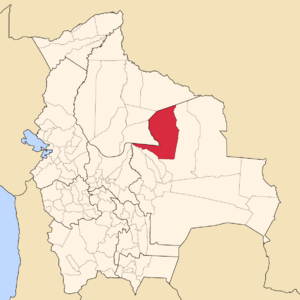Guarayos facts for kids
The Guarayos are an indigenous group who live on their traditional lands in eastern Bolivia. You can find them north of the Santa Cruz department. About 12,000 Guarayos people live in Bolivia today. They mostly speak Guarayu, which comes from the Guaraní language family. Most of the Guarayos (70%) are Roman Catholic, while the rest (30%) follow their own traditional religions. They are well-known for their farming, as much of their way of life depends on the land.
Contents
History of the Guarayos
The Guarayos likely moved to Bolivia from Paraguay many centuries ago. This happened when the Guaraní people attacked the edges of the Incan empire. Many believe the Guaraní are the ancestors of the Guarayos.
Long ago, the Guarayos and the Pauserna people were one group. One part of this group, who became the Guarayos, moved into special missions. The other part stayed independent and became known as the Pauserna. In the early 1880s, the Guarayos were contacted and brought together. They then started farming and raising cattle.
Guarayos Culture
Traditional Beliefs
The Guarayos have special beliefs about how the world was made. They believe three beings created the world: Alaangui, Mbirachucha, and Candir. They also respect Zaguaguayu as their very first ancestor.
Their traditional beliefs also explain marks on the moon. They say these marks are because of bad behavior from Abeulo, who they call their Great Father.
Guarayos Clothing
When missionaries first came to their villages, the Guarayos wore feather ornaments and body paint. They did not wear other clothes. Today, Guarayos women wear long cloth dresses. The men wear long tunics made from tree bark.
Guarayos Daily Life
Living in the Lowlands
The Guarayos live in the lowlands of Bolivia. They mostly hunt and gather food, and they are also small farmers. They grow crops like corn, bananas, and rice.
In the 1970s, Guarayos communities started forming groups called sindicatos. These groups helped them claim and share land. These sindicatos, also known as farming zones, were led by presidents chosen by the traditional village leaders.
Marriage and Family
It was hard for the Guarayos to stop their old marriage traditions, like a man having more than one wife. They did not easily accept the marriage customs of the church.
When a young woman wants to marry, she needs permission from both her father and her brother. It is often preferred for a man to marry his sister's daughter.
After a child is born, the father practices something called couvade. The father stays in his hammock for the first three days after his child is born. This is so the child's spirit will follow its father and stay safe from harm.
Beliefs About Death
When a Guarayos person dies, their spirit travels to the land of Tamoi, who is the Great Ancestor. This journey is full of dangers and temptations. At the end of the journey, Tamoi washes the spirit. After this, the spirit becomes young and beautiful again.
Guarayos Politics and Land
Central Organization of Native Guarayos Peoples (COPNAG)
When a new highway was built, it opened the Guarayos region to outsiders. Because of this, the Guarayos people created an important group called the Central Organization of Native Guarayos Peoples (COPNAG). Leaders for this group are chosen by representatives from all over the province.
COPNAG works to protect the interests of the Guarayos people. It also helps manage resources by creating plans for how to use the forests on their land. The organization also confirms old land claims.
COPNAG faced challenges with accusations of fraud because its leaders had a lot of power over land claims. The group eventually split. A new group, calling itself the 'authentic' COPNAG, took power. This new group was recognized by the Santa Cruz government. Daniel Yaquirera, the new President of COPNAG, has been working to protect their land from outside pressures, even with little help from the government.
The 1996 Forest Law
The 1996 Forest Law was an important step. It officially recognized the Guarayos as rightful users of the forest land they shared. This law was created during a time of big changes in Bolivia, to decide how the country's forest land would be used.
The law helped the Guarayos gain more control over their land. They were able to create 76 plans for managing their forests. However, the government has not always fully supported or protected these forest areas, which has caused problems. In recent years, soybean farmers have moved into the southern parts of the Guarayos' farmlands. This area is becoming more important for the economy. This has led to more problems, as organizations and the government sometimes ignore the Guarayos' land rights.
Road Development Project
A project called the BO Road Sector Capacity Development Project includes a plan for indigenous peoples. This project is funded by The World Bank and was approved in September 2015.
The project aims to help the Guarayos and Siriona people. It does this by encouraging respectful talks between different cultures. It also provides education on how to use roads safely and manage garbage. Since the Guarayos live in the project area, this plan was made to make sure they benefit from the project.
Evo Morales' Presidency
When Evo Morales became president of Bolivia in 2006, he was the first indigenous president. He promised hope to indigenous groups, including the Guarayos. He said he would stand with them and protect the environment.
However, between 2000 and 2017, deforestation in the Guarayos Indigenous Territory actually increased. This was due to more farming for goods to sell. During Evo Morales' time as president, the Guarayos' ability to govern themselves became weaker. This happened because the government focused more on taking natural resources and farming for export, rather than supporting the group's independence.
See also
 In Spanish: Guarayos para niños
In Spanish: Guarayos para niños


